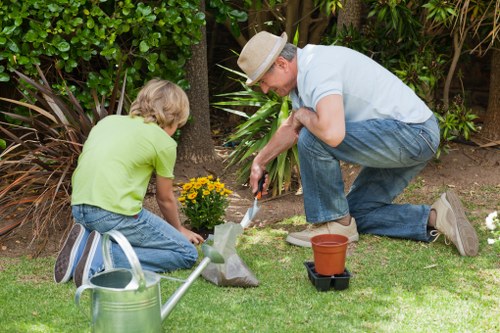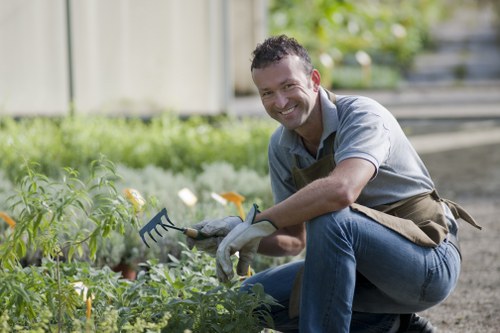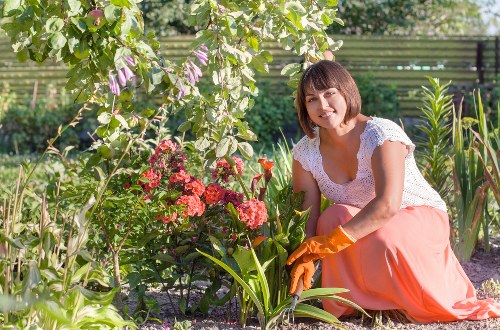Hedge Trimming Islington: Expert Tips for a Beautiful Garden

Maintaining a well-trimmed hedge not only enhances the aesthetic appeal of your garden but also promotes the health and growth of your plants. In Islington, where space can be limited, proper hedge trimming is essential for creating a lush and organized outdoor space.
Whether you're a seasoned gardener or a beginner, understanding the best practices for hedge trimming can make a significant difference. This article provides comprehensive insights into hedge trimming in Islington, ensuring your garden remains vibrant and well-kept throughout the seasons.
From selecting the right tools to knowing the optimal times for trimming, we'll cover everything you need to know to achieve professional-looking results right in your backyard.
Why Hedge Trimming is Important

Hedge trimming serves multiple purposes beyond just keeping your garden looking neat. Regular trimming ensures that your hedges grow in a healthy and controlled manner, preventing overgrowth and encouraging dense foliage.
Properly maintained hedges can also act as natural barriers, providing privacy and reducing noise from the bustling streets of Islington. Additionally, well-trimmed hedges can increase the value of your property by enhancing its curb appeal.
Neglecting hedge maintenance can lead to various issues, including pest infestations, diseases, and unsightly overgrowth. Therefore, regular trimming is crucial for maintaining both the health of your plants and the overall beauty of your garden.
Choosing the Right Tools for Hedge Trimming

Having the appropriate tools is essential for effective hedge trimming. The right equipment not only makes the job easier but also ensures precise cuts, promoting healthy growth.
Essential Hedge Trimming Tools
- Hedge Trimmers: Available in manual, electric, and gas-powered versions, hedge trimmers are the primary tool for shaping and cutting hedges.
- Pruning Shears: Ideal for smaller, detailed cuts and maintaining the shape of intricate hedges.
- Loppers: Perfect for tackling thicker branches that regular shears can't handle.
- Gloves and Safety Gear: Protect your hands and eyes while trimming to prevent injuries.
- Ladder: Necessary for reaching higher sections of tall hedges.
Investing in high-quality tools will ensure that your hedge trimming tasks are efficient and produce professional results. Regular maintenance of these tools, such as sharpening blades and cleaning after use, will also extend their lifespan.
The Best Time to Trim Hedges in Islington

Timing is crucial when it comes to hedge trimming. Trimming hedges at the right time of year can significantly impact their growth and overall health.
Optimal Seasons for Trimming
- Late Winter to Early Spring: This is the best time for the initial trim of the year. It prepares the hedges for new growth during the spring and summer months.
- Mid to Late Summer: A lighter trim during this period helps maintain shape and encourages dense foliage without causing undue stress to the plants.
- Avoid Trimming in Late Fall and Winter: Trimming during these seasons can make hedges more susceptible to frost damage and may inhibit healthy growth in the spring.
Additionally, it's essential to consider the specific type of hedge you have, as some varieties may have unique trimming requirements. Always research the optimal trimming schedule for your particular plants to ensure the best results.
Step-by-Step Guide to Trimming Your Hedge

Trimming your hedge doesn't have to be a daunting task. Follow these simple steps to achieve a beautifully maintained hedge:
1. Assess the Hedge
Begin by inspecting your hedge for any dead or diseased branches. Remove these first to promote healthy growth and prevent the spread of diseases.
2. Gather Your Tools
Ensure you have all the necessary tools at hand, including hedge trimmers, pruning shears, and protective gear.
3. Start Trimming
Begin trimming from the bottom and work your way up, maintaining an even height and shape. Use horizontal and vertical guides to achieve symmetry.
4. Focus on Shaping
Pay attention to the overall shape of the hedge. For formal hedges, aim for clean, straight lines, while natural hedges can have a more organic shape.
5. Clean Up
After trimming, collect and dispose of the clippings to prevent any potential pest or disease issues. Cleaning up also keeps your garden looking tidy.
Common Mistakes to Avoid
While hedge trimming is relatively straightforward, there are common mistakes that can hinder the health and appearance of your hedges:
- Over-Trimming: Cutting too much at once can stress the plant and lead to poor growth.
- Incorrect Timing: Trimming at the wrong time of year can negatively affect the hedge's health.
- Using Dull Tools: Unsharpened blades can cause jagged cuts, which may lead to infections and unhealthy growth.
- Ignoring the Shape: Failing to maintain a consistent shape can result in an unkempt appearance.
- Neglecting Regular Maintenance: Sporadic trimming can make it harder to maintain the desired shape and health of the hedge.
By being aware of these pitfalls, you can ensure that your hedge trimming efforts are both effective and beneficial to your garden's overall health.
Professional Hedge Trimming Services in Islington
While DIY hedge trimming is feasible, hiring professional services in Islington can provide expert results, particularly for large or complex hedges.
Benefits of Hiring Professionals
- Expertise: Professionals have the knowledge and experience to trim hedges effectively, ensuring optimal health and appearance.
- Time-Saving: Outsourcing hedge trimming frees up your time to focus on other gardening tasks or personal activities.
- Proper Equipment: Professionals come equipped with specialized tools that may not be readily available to homeowners.
- Safety: Trimming tall or thick hedges can be hazardous. Professionals are trained to handle these risks safely.
- Consistent Maintenance: Regular professional trimming ensures your hedges remain in top condition throughout the year.
When selecting a hedge trimming service in Islington, consider factors such as reputation, customer reviews, pricing, and the range of services offered to ensure you choose a reliable and competent provider.
Local Regulations and Considerations
Before undertaking hedge trimming in Islington, it's essential to be aware of any local regulations or guidelines that may apply, especially if your hedge borders public spaces or shared boundaries.
Planning Permissions
While most hedge trimming projects do not require planning permission, significant alterations or removals may be subject to local council regulations. It's advisable to check with the Islington Council to ensure compliance.
Neighborly Considerations
If your hedge forms a boundary with a neighbor's property, maintaining clear communication is key. Discuss your trimming plans to avoid disputes and ensure mutual satisfaction with the hedge's appearance.
Protected Species
Some hedges may be home to protected wildlife. Before trimming, verify that your hedge does not host any protected species to avoid legal complications and contribute to local biodiversity preservation.
Eco-Friendly Hedge Trimming Practices
Adopting eco-friendly practices in hedge trimming not only benefits the environment but also contributes to the long-term health of your garden.
Using Sustainable Tools
Opt for electric or manual hedge trimmers over gas-powered ones to reduce your carbon footprint. Additionally, maintaining your tools ensures they operate efficiently with minimal environmental impact.
Composting Clippings
Instead of disposing of hedge trimmings, consider composting them. Organic compost enriches your soil, promoting healthier plant growth and reducing waste.
Caring for Pollinators
Leave some hedge flowers untouched to provide habitats and food sources for pollinators like bees and butterflies, supporting local ecosystems.
Water Conservation
After trimming, ensure your hedges are well-watered during dry periods. Proper hydration supports recovery and reduces the need for excessive watering.
Maintaining Hedged Areas in Nearby Islington Areas
Islington is surrounded by several vibrant neighborhoods, each with its unique characteristics and gardening needs. Maintaining hedges in these areas requires consideration of local conditions and styles.
Camden
Close to Islington, Camden offers a mix of urban and green spaces. Hedge trimming here often involves managing smaller gardens and balcony plants, emphasizing neatness and compact growth.
Barnsbury
Known for its historic architecture, Barnsbury residents often opt for traditional hedge shapes that complement the area's classic aesthetics, requiring precise and careful trimming.
Highbury
Highbury's spacious residences typically feature larger hedges, necessitating more extensive trimming sessions to maintain their grandeur and privacy.
Petersham
Petersham's diverse community favors eclectic garden styles. Hedge trimming here may involve creative shapes and mixed plant species to reflect the area's vibrant culture.
Finsbury Park
With expansive parks and green areas nearby, hedge trimming in Finsbury Park focuses on integrating garden hedges with the surrounding natural landscape, promoting harmony and environmental balance.
Clissold
Clissold's blend of residential and commercial spaces means hedge trimming must cater to both private gardens and public areas, ensuring accessibility and aesthetic consistency.
Seven Sisters
The Seven Sisters area presents a challenge with its limited gardening space. Effective hedge trimming here emphasizes space-saving techniques and smart plant choices.
Dalston
Dalston's artistic vibe encourages unique hedge shapes and colorful plant selections, requiring tailored trimming approaches to support creative garden designs.
Archway
Archway's community-oriented environment calls for collaborative gardening efforts, including shared hedge trimming responsibilities and maintaining communal green spaces.
Harringay
Harringay's diverse population enjoys a variety of hedge plants, necessitating versatile trimming methods to accommodate different gardening preferences and plant types.
Tips for Healthy Hedge Growth
Maintaining healthy hedges involves more than just regular trimming. Incorporating good gardening practices ensures your hedges remain robust and vibrant.
- Proper Watering: Ensure your hedges receive adequate water, especially during dry spells. Deep watering encourages strong root growth.
- Fertilizing: Use appropriate fertilizers to provide essential nutrients, promoting healthy foliage and steady growth.
- Pest Control: Regularly inspect your hedges for signs of pests or diseases. Early detection and treatment prevent significant damage.
- Mulching: Apply mulch around the base of your hedges to retain moisture, suppress weeds, and regulate soil temperature.
- Pruning Dead Branches: Remove any dead or damaged branches promptly to prevent decay and encourage new growth.
By following these tips, you can ensure that your hedges not only look great but also thrive in the unique climate and conditions of Islington.
Innovative Hedge Trimming Techniques
Exploring innovative trimming techniques can add a unique touch to your hedges, making your garden stand out.
Topiary:
Topiary involves shaping hedges into artistic forms such as animals, geometric shapes, or abstract designs. This technique requires patience and precision but can result in stunning visual displays.
Ring Shaping:
Creating circular or oval shapes with your hedges can add a formal and structured look to your garden. This method is ideal for enclosing pathways or creating focal points.
Layered Trimming:
Layered trimming involves cutting hedges to different heights, creating depth and interest. This technique is excellent for adding dimension to large hedges.
Seasonal Variations:
Adjust your trimming approach based on the season. For example, lighter trims in summer can maintain shape without stressing the plants, while more significant trims in early spring can encourage vigorous growth.
Conclusion
Hedge trimming in Islington is a vital aspect of garden maintenance that enhances both the beauty and functionality of outdoor spaces. By understanding the importance of regular trimming, selecting the right tools, timing your trims appropriately, and considering local regulations, you can keep your hedges healthy and visually appealing throughout the year.
Whether you choose to tackle hedge trimming yourself or hire professional services, the key is consistency and attention to detail. Embracing eco-friendly practices and innovative trimming techniques can further elevate your garden, making it a true sanctuary in the bustling area of Islington.
Frequently Asked Questions
1. How often should I trim my hedge in Islington?
Generally, hedges should be trimmed at least twice a year – once in late winter or early spring and again in mid to late summer. However, the frequency may vary based on the hedge type and growth rate.
2. What are the best hedge plants for small gardens in Islington?
For small gardens, consider compact and low-maintenance hedge plants such as boxwood, yew, or privet. These varieties are easy to trim and maintain a neat appearance without taking up too much space.
3. Can I trim my hedge myself, or should I hire a professional?
While many homeowners successfully trim their hedges, hiring a professional can ensure precise and efficient results, especially for large or complex hedges. Professionals also have the expertise to handle unexpected challenges safely.
4. What tools do I need for effective hedge trimming?
Essential tools include hedge trimmers (manual, electric, or gas-powered), pruning shears, loppers, gloves, safety gear, and a ladder for reaching higher sections. Investing in quality tools will make the trimming process easier and more effective.
5. How can I promote healthy growth after trimming my hedge?
To encourage healthy growth, ensure your hedge is well-watered, fertilized appropriately, and free from pests and diseases. Mulching around the base can also help retain moisture and provide essential nutrients.